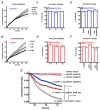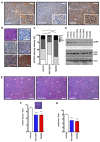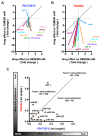Distinct Response of Circulating microRNAs to the Treatment of Pancreatic Cancer Xenografts with FGFR and ALK Kinase Inhibitors
- PMID: 35326668
- PMCID: PMC8945909
- DOI: 10.3390/cancers14061517
Distinct Response of Circulating microRNAs to the Treatment of Pancreatic Cancer Xenografts with FGFR and ALK Kinase Inhibitors
Abstract
Pancreatic adenocarcinoma is typically detected at a late stage and thus shows only limited sensitivity to treatment, making it one of the deadliest malignancies. In this study, we evaluate changes in microRNA (miR) patterns in peripheral blood as a potential readout of treatment responses of pancreatic cancer to inhibitors that target tumor-stroma interactions. Mice with pancreatic cancer cell (COLO357PL) xenografts were treated with inhibitors of either fibroblast growth factor receptor kinase (FGFR; PD173074) or anaplastic lymphoma kinase receptor (ALK; TAE684). While both treatments inhibited tumor angiogenesis, signal transduction, and mitogenesis to a similar extent, they resulted in distinct changes in circulating miR signatures. Comparison of the miR pattern in the tumor versus that in circulation showed that the inhibitors can be distinguished by their differential impact on tumor-derived miRs as well as host-derived circulating miRs. Distinct signatures that include circulating miR-1 and miR-22 are associated with the efficacy of ALK and FGFR inhibition, respectively. We propose that monitoring changes in circulating miR profiles can provide an early signature of treatment response or resistance to pathway-targeted drugs, and thus provide a non-invasive measurement to rapidly assess the efficacy of candidate therapies.
Keywords: biomarker; circulating miR; miR; microRNA; pancreatic adenocarcinoma; pancreatic cancer; stroma; treatment response.
Conflict of interest statement
The authors declare no conflict of interest.
Figures






Similar articles
-
MicroRNA expression profiling identifies molecular signatures associated with anaplastic large cell lymphoma.Blood. 2013 Sep 19;122(12):2083-92. doi: 10.1182/blood-2012-08-447375. Epub 2013 Jun 25. Blood. 2013. PMID: 23801630 Free PMC article.
-
Circulating microRNAs in patients with hormone receptor-positive, metastatic breast cancer treated with dovitinib.Clin Transl Med. 2017 Oct 4;6(1):37. doi: 10.1186/s40169-017-0169-y. Clin Transl Med. 2017. PMID: 28980224 Free PMC article.
-
Co-active receptor tyrosine kinases mitigate the effect of FGFR inhibitors in FGFR1-amplified lung cancers with low FGFR1 protein expression.Oncogene. 2016 Jul 7;35(27):3587-97. doi: 10.1038/onc.2015.426. Epub 2015 Nov 9. Oncogene. 2016. PMID: 26549034
-
Nucleophosmin-anaplastic lymphoma kinase: the ultimate oncogene and therapeutic target.Blood. 2017 Feb 16;129(7):823-831. doi: 10.1182/blood-2016-05-717793. Epub 2016 Nov 22. Blood. 2017. PMID: 27879258 Review.
-
Circulating exosomal microRNAs as emerging non-invasive clinical biomarkers in heart failure: Mega bio-roles of a nano bio-particle.IUBMB Life. 2020 Dec;72(12):2546-2562. doi: 10.1002/iub.2396. Epub 2020 Oct 14. IUBMB Life. 2020. PMID: 33053610 Review.
Cited by
-
Molecular Research in Pancreatic Cancer: Small Molecule Inhibitors, Their Mechanistic Pathways and Beyond.Curr Issues Mol Biol. 2023 Feb 27;45(3):1914-1949. doi: 10.3390/cimb45030124. Curr Issues Mol Biol. 2023. PMID: 36975494 Free PMC article. Review.
References
-
- American Cancer Society . Cancer Facts & Figures 2020. American Cancer Society; Atlanta, GA, USA: 2020. pp. 1–76.
-
- Rhim A.D., Oberstein P.E., Thomas D.H., Mirek E.T., Palermo C.F., Sastra S.A., Dekleva E.N., Saunders T., Becerra C.P., Tattersall I.W., et al. Stromal elements act to restrain, rather than support, pancreatic ductal adenocarcinoma. Cancer Cell. 2014;25:735–747. doi: 10.1016/j.ccr.2014.04.021. - DOI - PMC - PubMed
-
- Özdemir B.C., Pentcheva-Hoang T., Carstens J.L., Zheng X., Wu C.-C., Simpson T.R., Laklai H., Sugimoto H., Kahlert C., Novitskiy S.V., et al. Depletion of carcinoma-associated fibroblasts and fibrosis induces immunosuppression and accelerates pancreas cancer with reduced survival. Cancer Cell. 2014;25:719–734. doi: 10.1016/j.ccr.2014.04.005. - DOI - PMC - PubMed
Grants and funding
LinkOut - more resources
Full Text Sources

